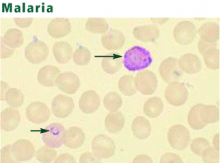Blood smear analysis in babesiosis, ehrlichiosis, relapsing fever, malaria, and Chagas disease
ABSTRACTBlood smear analysis is especially useful for diagnosing five infectious diseases: babesiosis, ehrlichiosis, relapsing fever due to Borrelia infection, malaria, and American trypanosomiasis (Chagas disease). It should be performed in patients with persistent or recurring fever or in those who have traveled to the developing world or who have a history of tick exposure, especially if accompanied by hemolytic anemia, thrombocytopenia, or hepatosplenomegaly.
KEY POINTS
- In the United States, malaria and American trypanosomiasis principally affect travelers from the developing world.
- Babesiosis, ehrlichiosis, and relapsing fever are transmitted by ticks and may produce thrombocytopenia and elevation of liver enzyme levels.
- Malaria and babesiosis cause hemolytic anemia and may be associated with hepatomegaly and splenomegaly.
- Recurring fever is typical of malaria and Borrelia infection.
MALARIA
Malaria is caused by protozoa of the genus Plasmodium. Injected during a mosquito bite, sporozoites enter the bloodstream and travel to the liver. During the asymptomatic hepatic stage, the sporozoites multiply within hepatocytes to form mature schizonts. Within 1 to 2 weeks, the schizonts rupture, releasing thousands of merozoites into the bloodstream. The merozoites enter red blood cells, where they mature through the trophozoite stage to become schizonts, which release more merozoites into the blood that may infect other red blood cells. Symptoms occur during this erythrocytic stage, usually 1 to 4 weeks after a mosquito bite.
Four Plasmodia species regularly cause human disease.48 All can digest hemoglobin and cause hemolysis. P falciparum is uniquely dangerous, in part because it can alter the erythrocyte surface and obstruct the microcirculation.49,50 Further, P falciparum can cause high levels of parasitemia because it can infect red blood cells in all stages of their maturation. In contrast, P vivax and P ovale invade only reticulocytes, so levels of parasitemia are low (< 1%). P vivax and P ovale produce dormant liver forms (hypnozoites), which may cause relapses, usually within 3 years of exposure. Falciparum malaria does not have a dormant form, so relapses do not occur. P malariae infects only mature red blood cells, producing low levels of parasitemia. A fifth malaria species once thought to be confined to monkeys, P knowlesi, is a rare cause of severe human disease.51
Up to a half-billion cases of malaria occur worldwide each year.52 Although the disease predominates among residents of endemic areas, about 30,000 travelers from industrialized countries are infected each year. Fewer than 1,000 cases are reported in the United States annually, which were usually acquired during travel to endemic areas.53,54 The risk of transmission varies from region to region, with highest rates (listed in descending order) occurring in Oceania, sub-Saharan Africa, the Indian subcontinent, Southeast Asia, South America, and Central America.55 More than 3 million people die of malaria annually, most of them in sub-Saharan Africa.
Malaria is transmitted principally by the bite of the female Anopheles mosquito but can also be transmitted by blood transfusion, by the use of contaminated needles, congenitally, and through organ transplantation. Because immigrants to the United States from endemic areas may harbor the parasites for months to years, malaria may rarely be acquired by autochthonous transmission, in which a parasitized individual infects competent vectors, which then bite uninfected persons.55 The disease may also be transmitted from parasitized mosquitoes that arrive on an aircraft (“airport malaria”). There is no animal reservoir for human malaria parasites.
Recurring fever
Fever is universally present, irrespective of the species causing infection. Common symptoms include malaise, chills, headache, myalgias, abdominal pain, night sweats, nausea, and diarrhea. Febrile episodes, initially frequent and irregular, may become regular, producing temperature spikes every second or third day depending on the species. The severity of the paroxysms usually diminishes over time. Eventually, anemia, thrombocytopenia, jaundice, splenomegaly, and hepatomegaly occur.
Falciparum malaria may result in pulmonary edema, renal failure, gastroenteritis, bleeding, or hypoglycemia. Cerebral disease, presenting as altered sensorium or seizures, can be fatal.56 Death, common in untreated patients, correlates with the degree of parasitemia.57 Severe disease often occurs in children, pregnant women, asplenic patients, and nonimmune adults.
Infection with P vivax or P ovale does not produce the microvascular complications of falciparum malaria, and thrombocytopenia is less common. P malariae infection may lead to immune complex deposition and nephrotic syndrome. Symptoms, although mild, are often prolonged.
Consider malaria in travelers with recurring fever
Antigen-capture test kits are useful for rapid diagnosis. These portable devices detect parasitic antigens from a drop of blood in just 15 minutes.61 Polymerase chain reaction techniques offer high sensitivity and specificity but are more expensive and less available.62
The management of patients with suspected malaria should be done by experienced health care providers. Recommendations about malaria treatment are beyond the scope of this review. The choice of antimalarial drugs requires knowledge of the regional distribution of drug resistance and the adverse effects of the agents. Patients with non-falciparum malaria rarely require hospitalization.
Malaria is prevented by mosquito avoidance and chemoprophylaxis.







